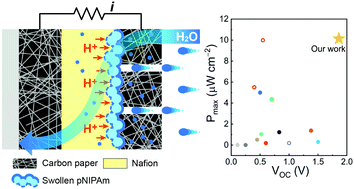Hydrovoltaic energy harvesting from moisture flow using an ionic polymer–hydrogel–carbon composite†
Abstract
Hydrovoltaic technologies have been proposed in recent years to generate electricity by virtue of water interacting with nanostructured materials, such as monolayer graphene and graphene derivatives, as promising renewable energy alternatives. In particular, moisture flow, with natural abundance in daily life, contains tremendous energy but remains unutilized. Here, we invented a new hydrovoltaic device comprising the ionic polymer Nafion and poly(N-isopropylacrylamide) hydrogel, by which an ultrahigh voltage of −1.86 V was reached using one single module in a sustainable manner and its fast voltage response is significantly distinguished from all moisture-enabled electric generators. Our device not only outperforms in power density but also the adaptability to moisture flow and the simplicity of the device, enabling energy recovery in various real-life scenarios from human breath to mechanical water spray and even water-cooling processes. Its practical significance as a portable power supply was demonstrated by charging capacitors and powering electrochromic smart windows without any auxiliary rectifying and amplifying circuits.



 Please wait while we load your content...
Please wait while we load your content...